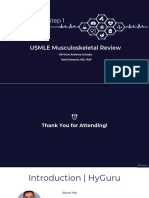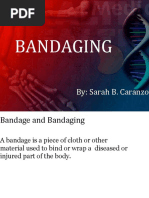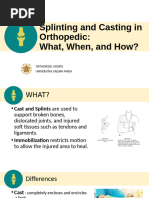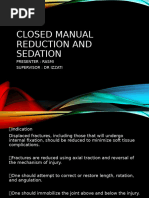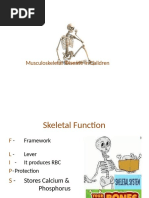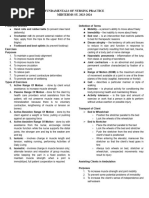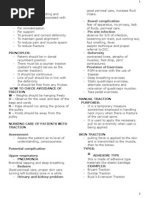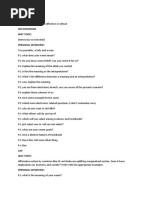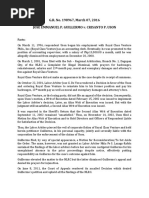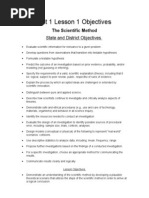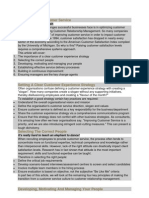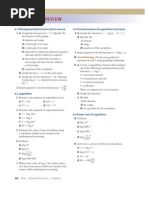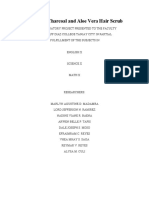OSPE Rev
OSPE Rev
Uploaded by
oni bugiCopyright:
Available Formats
OSPE Rev
OSPE Rev
Uploaded by
oni bugiOriginal Title
Copyright
Available Formats
Share this document
Did you find this document useful?
Is this content inappropriate?
Copyright:
Available Formats
OSPE Rev
OSPE Rev
Uploaded by
oni bugiCopyright:
Available Formats
BPCS:
- Bandaging techniques TRIANGULAR BANDAGE -
BANDAGE - a strip of material such as gauze used to protect,
immobilize, compress, or support a wound or injured body
part.
• ROLLER BANDAGE - is made of an elastic or a non-
elastic material formed in a cylindric roll & fabricated
in various widths & lengths.
• TRIRANGULAR BANDAGE (sling) – is a large piece of
cloth cut or formed into a triangle.
• ADHESIVE TAPE/ATHLETIC TAPE - Is used when
support or protection to a joint is needed with little
or no stretch to the bandage.
• PROTECTIVE SPLINTS OR SLEEVES - some patients
may find it necessary to use a splint or sleeve to
immobilize, stabilize, & protect a joint or to control
edema.
CIRCULAR – overlapping circular turns. OPEN:
• Top of Head
• Forint and Back of Head
• Front and Back of Chest
• Arm Sling
• Underarm Sling
• Hand and Foot
SPIRAL – series of overlapping diagonal turns.
Broad Cravat
• Abdominal
• Knee
Semi – Broad Cravat :
• Shoulder and Hip
SPIRAL REVERSE – series of spiral turns, which is folded or • Arm and Leg
reversed on itself. • Elbow
Narrow Cravat
• Forehead
• Eye
• Neck
RECCURENT – lengthwise layers applied to the anterior- • Ear, Cheek, and Jaw
posterior or dorsal-volar surfaces of an extremity or digit.
- Transfer/Carrying methods
Tagging of Patients (MCI – Mass Casualty Incidence )
Priority One ( RED TAG ) – needs immediate care / life
threatening ( No Pulse, No Respiration )
Priority Two ( YELLOW TAG ) – ok status ( Delayed care for 1
FIGURE OF EIGHT - a series of spiral turns applied in alternate hour )
directions.
Priority Three ( GREEN TAG ) – ok status ( Hold care, walking
victims, around 3 hours )
Priority Four ( BLACK TAG ) – no care needed ( possibly dead )
SPICA - incorporates the figure-of-eight pattern, but a large
anchor or spica is applied around the pelvis to prevent the
distal portion of the bandage from sliding down the extremity
to which it is applied
• One-Man Assist / Carries / Drags • Three-Man Assist / Carries
- Assist to walk - Bearers alongside (narrow alleys)
- Carry in arms / Cradle
- First aid and specific incidents
1. Shock
- Pack Strap
• Warmth
• Air
• Rest
• Mental Rest
• treat the cause of the shock and aim to prevent
further fluid loss
- Piggy back 2. Wounds
Treating Minor Wounds: If possible, wash your hands before
treating the wound. Check that there is nothing in the wound.
( can be treated in the home without the need for further
medical attention.)
INFECTED WOUNDS - Cover the wound with a sterile dressing
and bandage into place. Raise the injured part if possible, to
- Fireman’s
reduce swelling and pain. Seek early medical advice. Treat for
shock necessary.
3. FRACTURE (broken bone)
• Two-Man Assist / Carries
- Assist to walk
1. CLOSED (simple) Fracture – bone has broken but has not
pierced the skin.
2. OPEN (compound) Fracture – where bone has either
pierced the skin, and as it is associated with open wound
- Four Hand Seat
TREATMENT: *Keeping a Broken still, steady and support * if
transporting, immobilize the broken bone further
withbandages or improvise with coats or blankets
• Not to tie the bandage too tightly
• To pad around the site of the break.
• Do not move the injured area unnecessarily.
- Carry by Extremities 4. BURN
CAUSES OF BURNS
Dry Heat – Most Common type, caused by cigarettes or
lighter, direct contact in fire.
Wet Heat – known as SCALDS, like hot liquids (water,oil etc.)
Chemical burns – Industrial and household chemicals
Electrical Burns - causes by high voltage electricity power
Radiation Burns – Sunburn
Cool up for 10 mins, maintain airway… 11. SEIZURE – symptom of epilepsy (lasts 1 – 2 min or longer)
5. HEAD INJURY The electrical impulses lead to a contraction in the muscles
that causes the epilepsy sufferer to fall to the ground with a
6. POISON
cry (known as TONIC PHASE)
-Salmonella is on of the most common culprits and is found in
• The victim’s muscles may then go into spasm (Clonic Stage)
many farm products such as eggs
TREATMENT:
and chickens.
• Do not try to restrain or the person during seizure.
-Toxic (potentially lethal) food poisoning such as botulism can
be due to poisons caused by bacteria in certain types of food, • Stay with a person until the seizure ends naturally. Do
including honey and fish not leave him or her alone until the person is fully
conscious, alert, and able to speak normally.
7. Animal Bites
• Loosen ties, scarves, or anything around the neck that
• Rabies – is an increasingly rare but potentially very serious,
could interfere with breathing.
even fatal, condition carried by animal bites.
• Clear the area around the person of anything hard or
• *There is no cure for rabies but early vaccination following a
sharp. Remove glasses.
bite can help develop immunity.
• Hepatitis B & C – there is a small chance that hepatitis B
and C may be transmitted by a human bite. If concerned, seek DOTS :
medical advice.
D=eformity, O=pen Wounds, T=enderness, S=swelling
• Tetanus – Tetanus bacteria carry a particular risk when
1. Head
carried deep into a wound.
- check the scalp for DOTS
8. EPISTAXIS (nosebleed)
2. Eyes
9. HYPERVENTILATION
- PERRL (Pupils Equal Round React to Light)
- Signs of hyperventilation include:
3. Ears and Nose – for clear blood-tinged fluid
1. Shortness of Breath (SOB)
4. Mouth – for swelling or objects (e.g broken teeth,
2. Fast Breathing (more than 40 breaths per minute)
dentures,
3. Tingling or numbness of the hands, feet, and around the
chewing gum, vomiting food =, and foreign objects) which
mouth.
could
10. AIWAY OBSTRUCTION
block the airway
Cardiopulmonary Resuscitation (CPR)
5. Neck – for DOTS. Look for a medical identification
1. Check for the responsiveness and look for signsof necklace chain
breathing and gasping
6. Chest – for DOTS
- If the victim is unresponsive and has a normal breathing,
7. Abdomen for DOTS
place the victim in the recovery position, and have someone
call emergency team 8. Pelvis
2. Provide chest compressions 9. Check for all four extremities – Ciculation, Sensation
and Movement
- Give 30 chest compressions in the center of the victim’s
chest 10. The Back – for DOTS
3. Open Airway:
- Tilt the victim’s head back and lift the chin
4. Give 2 breaths:
- Each breath lasts 1 second to produce visible chest rise.
5. Continue CPR until AED is available
*FOR RESPONSIVE INFANTS (BIRTH TO 1 YEAR)
1. Support the infant’s head, neck, and back.
2. Alternate five back blows followed by five chest
compressions repeatedly
FAPM GLUTEUS MEDIUS, GLUTEUS MINIMUS
A: Abduction of Hip Joint
1. Lumbosacral plexus
N: Superior Gluteal Nerve
PIRIFORMIS
A: Lateral Rotation of HJ
N: S1 and S2
Gemellus Superior, Gemellus Inferior
A: Lateral Rotation of HJ
N: Sacral Plexus
Obturator Internus
A: Lateral Rotation of HJ
N: Sacral Plexus
RECTUS FEMORIS
A: Flexion of HJ; Ext of KJ
N: Femoral Nerve
Vastus Lateralis/Medialis/Intermedius
A: Extension of Knee joint
N: Femoral Nerve
BICEPS FEMORIS
A: Ext of HJ and KJ; Lat Rot of HJ
N: Obturator Nerve
GASTROCNEMIUS, PLANTARIS, POPLITEUS
A: Flexion of KJ; Plantarflexion of
2.Boundaries of popliteal fossa Ankle Joint
N: Tibial Nerve
• Superomedial border – semimembranosus. POPLITEUS
• Superolateral border – biceps femoris. A: Flexion of Knee Joint
• Inferomedial border – medial head of the N: Obturator Nerve
gastrocnemius.
• Inferolateral border – lateral head of the
gastrocnemius and plantaris. FAPN
3.Actions of thigh,leg muscles - Cranial nerves and their assessment
ILIACUS - Peripheral NS
A: Flexion of Hip joint
- Spinal cord
N: Femoral Nerve
PSOAS MAJOR - Autonomic NS
A: Flexion of Hip joint
N: Lumbar Plexus FAPC
RECTUS FEMORIS parts of the upper and lower respiratory tracts.
A: Flexion of HJ, Ext of KJ
N: Femoral Nerve explain the V/Q.
SARTORIUS
V/Q or Ventilation-perfusion ratio, is a measurement used
A: Flexion, Abduction and LR of HJ
in respiratory physiology to assess the efficiency of gas
Flexion and MR of KJ
exchange in the lungs. It compares the amount of air
N: Femoral Nerve
reaching the alveoli (ventilation) to the amount of blood
TENSOR FASCIA LATAE
perfusing the pulmonary capillaries (perfusion).
A: Flexion, Abduction and Medial Rotation
of Hip Joint; Extension of KJ
N: Superior Gluteal Nerve
PECTINEUS
A: Flexion and Adduction of HJ
N: Femoral Nerve
ADDUCTOR LONGUS,BREVIS,MAGNUS
A: Adduction; assist LR of HJ
N: Obturator Nerve
GRACILIS
A: Adduction; assist LR of HJ, Flexion of KJ
N: Obturator Nerve
GLUTEUS MAXIMUS
A: Extension, LR of HJ; Ext of KJ
N: Inferior Gluteal Nerve
BICEPS FEMORIS
A: Ext, LR of HJ; Ext of KJ
N: LH – Tibial portion Sciatic Nerve
SH – Common Peroneal Nerve
SEMITENDONOSUS, SEMIMEMRANOSUS
A: Ext of HJ; Flexion and MR of KJ
N: Tibial portion of Sciatic Nerve
You might also like
- The American Physical Therapy Association Book of Body Repair and Maintenance: Hundreds of Stretches and Exercises for Every Part of the Human BodyFrom EverandThe American Physical Therapy Association Book of Body Repair and Maintenance: Hundreds of Stretches and Exercises for Every Part of the Human BodyRating: 4 out of 5 stars4/5 (9)
- Maths and Science Infant Ecd - Grade 2Document35 pagesMaths and Science Infant Ecd - Grade 2hil67% (3)
- 100 Concepts PDFDocument84 pages100 Concepts PDFDar100% (2)
- Splints+Tra: Guided By: Dr. PRAKASH D.RDocument111 pagesSplints+Tra: Guided By: Dr. PRAKASH D.Rlailatul husnaNo ratings yet
- Return Demonstration: Medical Emergencies Common Medical EmergenciesDocument7 pagesReturn Demonstration: Medical Emergencies Common Medical EmergenciesMarc Angelo DareNo ratings yet
- First Aid Lesson HandoutsDocument3 pagesFirst Aid Lesson HandoutsGuia Camandang100% (1)
- Health Reviewer (Q3)Document2 pagesHealth Reviewer (Q3)summer.pesaNo ratings yet
- Elbow TraumaDocument62 pagesElbow Traumadrcoolcat2000No ratings yet
- Manual HandlingDocument24 pagesManual Handlingwiss gaderNo ratings yet
- NCM 121 Skills MidtermDocument5 pagesNCM 121 Skills MidtermShiehan Mae ForroNo ratings yet
- Suspected Spinal Injuries 20230525Document22 pagesSuspected Spinal Injuries 20230525th4t1wr0ngk1dNo ratings yet
- Closed Reduction, Traction, and Casting Techniques: Jason Tank, MDDocument75 pagesClosed Reduction, Traction, and Casting Techniques: Jason Tank, MDluckyariadneeNo ratings yet
- SPLINTSDocument42 pagesSPLINTSRachit SekhrajkaNo ratings yet
- BandagingDocument25 pagesBandagingapi-380205981% (27)
- First AidDocument44 pagesFirst AidHarish SurendrakurupNo ratings yet
- Bandaging and Transport-2Document51 pagesBandaging and Transport-2sarah caranzoNo ratings yet
- Bandaging TechniquesDocument4 pagesBandaging TechniquesRaymark sancha100% (1)
- First AidDocument98 pagesFirst AidTcko. BlandoNo ratings yet
- StretchersDocument11 pagesStretchershimanshu.kr8686No ratings yet
- 04 Bandaging - NEWDocument21 pages04 Bandaging - NEWAhmad SobihNo ratings yet
- Skills 104 - FinalsDocument35 pagesSkills 104 - Finalsannie lalangNo ratings yet
- Back Pain Strain/Sprain Prevention: M.C. Nachtigal, ARNP, ND JHU/PBC Employee Health & Wellness CenterDocument17 pagesBack Pain Strain/Sprain Prevention: M.C. Nachtigal, ARNP, ND JHU/PBC Employee Health & Wellness CenterMohammad AliNo ratings yet
- Emed - BLS - FBAO - First Aid Part2Document87 pagesEmed - BLS - FBAO - First Aid Part2Princess Cate MercadoNo ratings yet
- 3.splinting, Bandaging and Strapping Sem 3Document26 pages3.splinting, Bandaging and Strapping Sem 3Wana IswaraNo ratings yet
- Common Health Problems in AdolescentDocument11 pagesCommon Health Problems in Adolescent2BGrp3Plaza, Anna MaeNo ratings yet
- Splinting and Casting in Orthopaedic - EditedDocument44 pagesSplinting and Casting in Orthopaedic - Editedsonnywijanarko91No ratings yet
- Health NotesDocument11 pagesHealth Noteslea.altarNo ratings yet
- NSTP1 Basic First Aid Vital Signs and Bandaging TechniquesDocument4 pagesNSTP1 Basic First Aid Vital Signs and Bandaging TechniquesErisNo ratings yet
- FracturesDocument8 pagesFracturesacentino121No ratings yet
- Spinal Injuries: What Are The Signs?Document2 pagesSpinal Injuries: What Are The Signs?Laura LucaNo ratings yet
- 5.forceps DeliveryDocument51 pages5.forceps Deliverysanthiyasandy100% (3)
- Closed Reduction, Traction and Casting Techniques CME- RASMI 6Document32 pagesClosed Reduction, Traction and Casting Techniques CME- RASMI 6teanmolee thirumugamNo ratings yet
- Body Bandage NSTPDocument20 pagesBody Bandage NSTPmirentolentino12No ratings yet
- Acute Care Study GuideDocument31 pagesAcute Care Study Guideburnermyth2No ratings yet
- Overview of Basic First AidDocument45 pagesOverview of Basic First Aidtvx8qbhtg9No ratings yet
- Bandages: Andrada, Ramo Jose E. Naknorasing, PimthanwaDocument28 pagesBandages: Andrada, Ramo Jose E. Naknorasing, PimthanwaNdor BariboloNo ratings yet
- NSTP 002 - Midterm ReviewerDocument8 pagesNSTP 002 - Midterm ReviewerDENIEL MIKE DUKANo ratings yet
- Week 16 - Musculoskeletal Disease in ChildrenDocument51 pagesWeek 16 - Musculoskeletal Disease in ChildrenJaja ManezNo ratings yet
- Instrumental and Distructive DeliveryDocument66 pagesInstrumental and Distructive DeliveryDagnachew kasayeNo ratings yet
- Shoulder - Rotator Cuff - Arthroscopic Rotator Cuff Repair Medium To Large Tears (Type II) PDFDocument4 pagesShoulder - Rotator Cuff - Arthroscopic Rotator Cuff Repair Medium To Large Tears (Type II) PDFAndresLeivaMckendrickNo ratings yet
- YEAR 1 and 2 OSCE Revision: Author: DR Thomas PayneDocument30 pagesYEAR 1 and 2 OSCE Revision: Author: DR Thomas Payneminayoki100% (1)
- First Aid - PC-IDocument140 pagesFirst Aid - PC-ItzeethiopiaNo ratings yet
- Funda MidtermsDocument18 pagesFunda Midtermsjomari macasaetNo ratings yet
- HEALTH 9 - Lecture 6 First Aid Basics and Vital SignsDocument54 pagesHEALTH 9 - Lecture 6 First Aid Basics and Vital SignsZeus MacatangayNo ratings yet
- Lifting and Moving Patients: Emergency Medical Technician - BasicDocument24 pagesLifting and Moving Patients: Emergency Medical Technician - BasicYoga IndraNo ratings yet
- Rehabilitation Guidelines For Total Hip (Anterior) ArthroplastyDocument4 pagesRehabilitation Guidelines For Total Hip (Anterior) ArthroplastydvenumohanNo ratings yet
- Edited - Adhesive CapsulitisDocument5 pagesEdited - Adhesive Capsulitiseternal_lynnNo ratings yet
- BandagingDocument3 pagesBandagingNavas PkNo ratings yet
- Unintentional Injury Prevention, First Aid and SafetyDocument25 pagesUnintentional Injury Prevention, First Aid and SafetyCasNo ratings yet
- Knee (Word)Document18 pagesKnee (Word)dwNo ratings yet
- Skills 2 (Patient Handling)Document15 pagesSkills 2 (Patient Handling)doved97451No ratings yet
- Final Handouts in Hope 4Document3 pagesFinal Handouts in Hope 4Khemme UbialNo ratings yet
- TractionDocument4 pagesTractionGly MtgNo ratings yet
- LS123Document7 pagesLS123GeorgiaNo ratings yet
- Shoulder Examination ChecklistDocument5 pagesShoulder Examination ChecklistseanselvamaniNo ratings yet
- Orthopedics BY MRDocument133 pagesOrthopedics BY MRjafarnadar.jnNo ratings yet
- P-E ReviewerDocument4 pagesP-E ReviewerdaniapslapulapuNo ratings yet
- 3.2 Management of Musculoskeltal Disorders PDFDocument2 pages3.2 Management of Musculoskeltal Disorders PDFDiana CalderonNo ratings yet
- Lesson - Elbow Region Examination and EvaluationDocument8 pagesLesson - Elbow Region Examination and EvaluationJULIANE MAE BALANGNo ratings yet
- TractionDocument19 pagesTractionNikko Melencion0% (1)
- Reduction, Relocation and Splinting in Emergency Room (RASER)From EverandReduction, Relocation and Splinting in Emergency Room (RASER)No ratings yet
- The Christmas VillageDocument39 pagesThe Christmas VillageVictoria ButtaroNo ratings yet
- Gepi MaterialDocument45 pagesGepi MaterialAshiee JainNo ratings yet
- All Annexure 3,7,8,9,10Document5 pagesAll Annexure 3,7,8,9,10prafful_hereNo ratings yet
- (Cheat - GG) Fiveduels Silent Aim ScriptDocument2 pages(Cheat - GG) Fiveduels Silent Aim ScriptDo Dong0% (1)
- Ece-213 Lab7 10-27-2020 OwenblairDocument8 pagesEce-213 Lab7 10-27-2020 Owenblairapi-548288377No ratings yet
- Yajur Veda Sandhya VandanamDocument16 pagesYajur Veda Sandhya Vandanamsuresh.srinivasnNo ratings yet
- Financial Economics Bodie Merton PresentationDocument5 pagesFinancial Economics Bodie Merton PresentationPaul Cheslaw0% (1)
- Gateway A1+ Everyday English AudioscriptDocument2 pagesGateway A1+ Everyday English AudioscriptHa NguyenNo ratings yet
- G.R. No. 198967, March 07, 2016 Jose Emmanuel P. Guillermo V. Crisanto P. UsonDocument9 pagesG.R. No. 198967, March 07, 2016 Jose Emmanuel P. Guillermo V. Crisanto P. UsonLily MondaragonNo ratings yet
- BaocaoDocument25 pagesBaocaoDang Tuan LongNo ratings yet
- Shear Design of Beams: CE 470 - Steel Design ClassDocument16 pagesShear Design of Beams: CE 470 - Steel Design Classcecdesign09No ratings yet
- Relationship With The Secondary and Tertiary Stakeholders Prepared byDocument18 pagesRelationship With The Secondary and Tertiary Stakeholders Prepared byJetmark Remegio100% (3)
- HP Proliant, Oneview and 3par Deployment Guide With Microsoft Hyper-V and SCVMM 2012 R2Document44 pagesHP Proliant, Oneview and 3par Deployment Guide With Microsoft Hyper-V and SCVMM 2012 R2Balasubramanian ReguramanNo ratings yet
- FIN 5190. Final Project Evaluation of Google and Apple Yuanyuan PanDocument7 pagesFIN 5190. Final Project Evaluation of Google and Apple Yuanyuan PanThethanh PhamnguyenNo ratings yet
- Assignment - 1: Information Systems and Digital FirmsDocument12 pagesAssignment - 1: Information Systems and Digital FirmsKartik SinghNo ratings yet
- (FREE PDF Sample) Savonarola The Rise and Fall of A Renaissance Prophet 1st Edition Donald Weinstein EbooksDocument68 pages(FREE PDF Sample) Savonarola The Rise and Fall of A Renaissance Prophet 1st Edition Donald Weinstein Ebooksfibionsumiga100% (5)
- Greedy Is An Algorithmic Paradigm That Builds Up A Solution Piece by Piece, AlwaysDocument7 pagesGreedy Is An Algorithmic Paradigm That Builds Up A Solution Piece by Piece, AlwaysNibedan PalNo ratings yet
- Psychological Perspective of The Self: Person. Having Its Own or Single Character As A PersonDocument5 pagesPsychological Perspective of The Self: Person. Having Its Own or Single Character As A PersonJanderick DeveraNo ratings yet
- Seance 1 The West Wind Cours Eleves Mercredi Et SamediDocument10 pagesSeance 1 The West Wind Cours Eleves Mercredi Et SamediÉloi mertzNo ratings yet
- Optical Complex Spectrum Analyzer AP244XB - APEX TechnologiesDocument4 pagesOptical Complex Spectrum Analyzer AP244XB - APEX TechnologiesAPEX TechnologiesNo ratings yet
- Unit 1 Lesson 1 The Scientific Method - 1Document3 pagesUnit 1 Lesson 1 The Scientific Method - 1k0ltenNo ratings yet
- 431 Classroom DynamicsDocument18 pages431 Classroom Dynamicsozigan16No ratings yet
- 6 Steps From Customer ServiceDocument3 pages6 Steps From Customer ServiceSaranya SaranNo ratings yet
- Chapter 1 Solutions 5th Edition 112612 FinalDocument8 pagesChapter 1 Solutions 5th Edition 112612 FinalFebby Lestari100% (1)
- Current Issue All Over Your FaceDocument7 pagesCurrent Issue All Over Your FaceanniNo ratings yet
- KathopanishadDocument24 pagesKathopanishadAjit Chintaman DalviNo ratings yet
- Chapter 6 ReviewDocument2 pagesChapter 6 ReviewKnoll7110% (1)
- Investigatory ProjectDocument31 pagesInvestigatory Projectmarlyn madamba100% (1)
- Self Inflating TyresDocument14 pagesSelf Inflating TyresShiva BharathNo ratings yet


